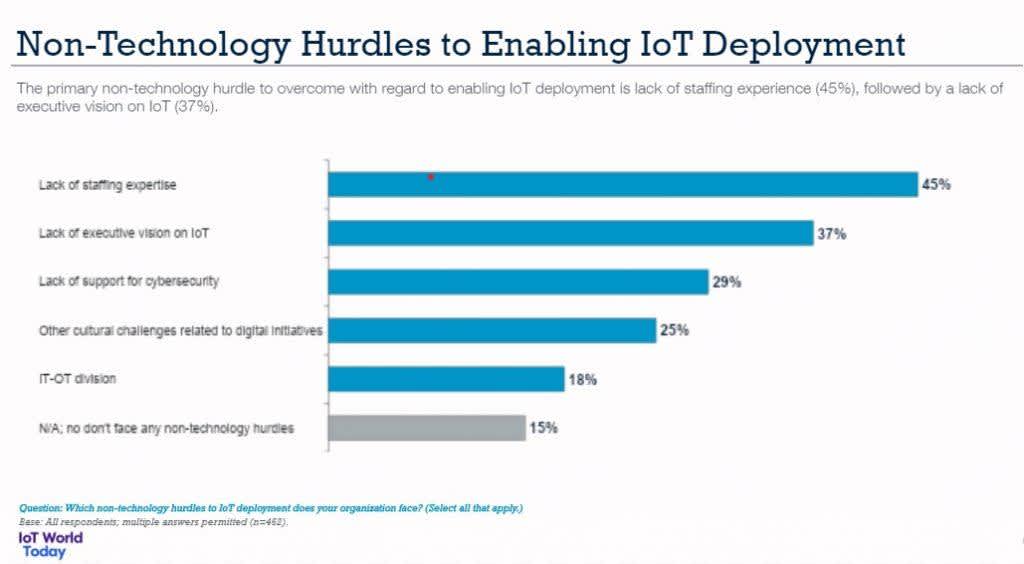Wearables and other internet-of-things (IoT) products are becoming increasingly popular, but there's a skill gap when it comes to hiring in-house developers. For instance, three-quarters of IoT product makers said demand for IoT developers outstripped supply last year, resulting in steep competition and high developer salaries.
The difficulty of hiring new IoT developers has left most companies upskilling internal engineers or outsourcing app development to partners. But of course, both of these paths involve their own set of risks and benefits to consider. And the success of IoT endeavors increasingly relies on successfully navigating these paths.
Let's take a look at how to upskill existing engineers or outsource development to an experienced partner—and how to choose the best option for your business.
Upskill to Build In-House
Large companies building IoT products may already have a sizable in-house talent pool. Since these engineers are already familiar with the business, companies may prefer to upskill their in-house workforce. That way, they can avoid any disruption to the team dynamic and potentially benefit from lower long-term labor costs.

What non-technical challenges face IoT development? Source: IoT World Today
Of course, upskilling engineers comes with its own set of challenges. A PwC survey of C-level executives found that only 18% of respondents made "significant progress" toward upskilling in their organization, although 36% said they made "some progress." In other words, upskilling involves a significant time and investment in an engineering team.
The ideal candidates for upskilling are highly-motivated, knowledgeable about the business, and are up-to-speed with at least some IoT technologies. In addition to hard skills, it's important to develop soft skills around user interface design and user collaboration. You can then help develop these skills through training or mentorship.
#Outsource To Reduce Risk
Smaller companies often outsource development to reduce risk. After all, hiring and onboarding new engineers takes time and money. If the product doesn't work out, they may need to retrain or lay off these employees. It's typically much cheaper to outsource development to a team of experts using a short-term contract.
You can also outsource parts of IoT development:
Research & Development: Partners can provide an outside perspective and help validate product ideas. They can even help create minimum viable products (MVPs) to test hypotheses before investing in large-scale development.
Engineering: Partners can often take on an entire project or complement your existing team. A typical example is developing a version of an app for another platform (e.g., Android). That way, your team can focus on their core competencies.
UI/UX: Partners can help add user-focused skills to any team, such as user experience design. As IoT devices reach mainstream consumers, UX has become a critical competitive differentiator, meaning these skills are essential to success.
Cloud: Cloud services and DevOps can be painful to set up and manage for those without experience. Fortunately, partners can help establish cloud services and ensure that everything runs smoothly before handing control off to internal teams.
Security: Partners can help assess security and address any vulnerabilities. Unless you have a DevSecOps team, security is often an afterthought for businesses. And the consequences can be far-reaching in the event of a data breach.
Outsourcing provides access to a wide range of talent, including engineering, user experience, cloud services, and security experts—all in a single invoice. As a result, you can quickly bring your IoT app to market. And if things don't work out, you can terminate the contract and scale down expenses to contain the losses.
In addition, outsourcing development can help augment your internal engineering team. These kinds of "team augmentation" efforts can ensure a smooth hand-off when the contract is complete and help internal developers take over long-term maintenance or even future feature development activities.
How To Find The Right Partner
Many companies have had bad experiences when outsourcing software development. In some cases, that's due to poor engineering talent. In other cases, it's due to a breakdown in communication. Fortunately, the right outsourcing partner can provide top-tier quality and clear communication at a fraction of the price of in-house developers.
When outsourcing software development, the most common mistake is going with the lowest bidder. While the lowest bidder isn't necessarily the worst option, the best value is more important than the lowest price. The best outsourcing partners have a long list of happy clients and work on projects in your vertical market—including IoT devices.
Some essential questions to ask an outsourcing partner include:
Do you have any client references that we can call?
What projects have you worked on in our industry?
What projects have you worked on using our tech stack?
Do you have any sample code that we can review?
What kind of long-term maintenance do you provide?
How do you handle communication throughout the contract?
intent has over ten years of experience bringing connected device projects to market. Our team has a combination of low-level IoT knowledge and high-level user experience design expertise. As a result, we can help you build high-quality and high-performance apps to power your IoT ambitions and unlock your business's value.
Contact us to discuss your project for free!
The Bottom Line
Internet-of-things products are quickly becoming ubiquitous across both consumer and business markets. However, since the market is relatively new, development and engineering resources remain thin. As a result, many companies choose to either upskill their existing engineers or outsource development to experienced partners.
The best option depends on the business, but most startups and mid-sized companies outsource. If they have in-house talent, they may selectively outsource certain parts of development to address skills gaps and even use partners to help educate their employees.
If you're interested in this option, contact us to discuss your project further!

Greg Cargopoulos
Marketing Lead

